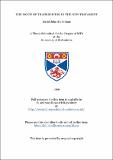Files in this item
The motif of thanksgiving in the New Testament
Item metadata
| dc.contributor.advisor | Wilson, R. McL. (Robert McLachlan) | |
| dc.contributor.author | McFarlane, David John | |
| dc.coverage.spatial | 134 p. | en_US |
| dc.date.accessioned | 2019-08-13T10:02:49Z | |
| dc.date.available | 2019-08-13T10:02:49Z | |
| dc.date.issued | 1966 | |
| dc.identifier.uri | https://hdl.handle.net/10023/18301 | |
| dc.description.abstract | “Several years ago while preparing a Bible study on Colossians for a women's study group, I became interested in the frequent mentioning of thanksgiving in that book, and throughout the New Testament, as an appropriate act or response for a Christian. I began to ask, then, in what way thanksgiving and gratefulness were involved in Christian discipleship in the New Testament. It seemed at the time that thanksgiving, so easily considered commonplace, in fact might be of fundamental significance to New Testament theology and ethics. While I have now modified that provisional idea, I am thoroughly convinced of a deliberate and significant role played by the motif of thanksgiving in the life of the early Church. In English translations of the New Testament the word 'thanksgiving' and its cognate terms 'gratefulness' and 'gratitude' are used to render several different Greek words: the noun charis (Romans 7.25); the verbs eulogein (Matthew 26.26), exhomologeisthai (Matthew 11.25), anthomologeiomai (Luke 2.38), and eucharistein (I Corinthians 1.4); and the phrase charin echein (Luke 17.9). Because of the number of occurrences, and the consistency of translation of eucharistein (euoharistia, euchariatos) with the concept of 'thanksgiving' it seemed reasonable to centre this study on eucharistein, drawing in the other Greek words as their relationship to the more prominent term became helpful. When, a year ago, it became possible for me to concentrate completely on this subject, it was suggested to me that the best place to begin would be the thanksgiving periods opening the Pauline letters, for here was a fixed form in which to examine thanksgiving, and a base from which the study could branch out. The thanksgiving periods are explored, therefore, as products of Hellenistic epistolary form in Chapter I, and as products of Biblical and Hellenistic ideas of gratitude in Chapter II. In Chapter III a proposal is discussed that the New Testament occurrences of thanksgiving might be coloured to some extent by Gnostic theology. These several proposals do not, I think, produce sufficient explanation for the New Testament usage of eucharistein. and in Chapters IV and V I turn to explore the employment of this term as a translation term from the motif of praise and affirmation in Judaism which, I feel, does explain its use in the New Testament. Chapter VI attempts to place this employment of eucharistein in relationship to other themes of the ancient world, and concludes with a summation of the course of the study." -- from the Preface. | en_US |
| dc.language.iso | en | en_US |
| dc.publisher | University of St Andrews | |
| dc.subject.lcc | BS2545.T52M2 | |
| dc.title | The motif of thanksgiving in the New Testament | en_US |
| dc.type | Thesis | en_US |
| dc.type.qualificationlevel | Doctoral | en_US |
| dc.type.qualificationname | MTh Master of Theology | en_US |
| dc.publisher.institution | The University of St Andrews | en_US |
This item appears in the following Collection(s)
Items in the St Andrews Research Repository are protected by copyright, with all rights reserved, unless otherwise indicated.

